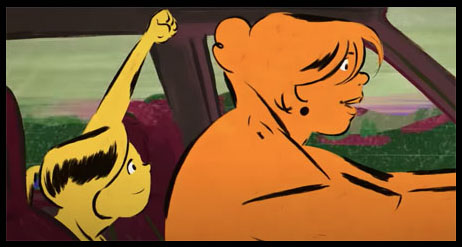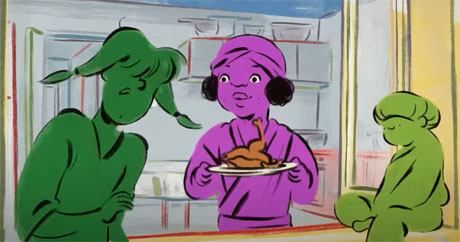
Chiara Malta and Sébastien Laudenbach are the directors of the new French animated dramedy Chicken for Linda! GKIDS opened the 2023 Annecy International Film Festival Cristal for Best Animated Feature winner in NYC last Friday. It hits Los Angeles this Friday April 12th and will be in other markets throughout North America later this month. The film is about a mother and daughter on a quest to make a meal that’s significant to them, chicken with peppers. Malta and Laudenbach share the ingredients for how they put Chicken for Linda! together in this Animation Scoop Q&A. (This interview was conducted over Zoom with a translator, and it was edited for length and clarity.)
Jackson Murphy: Chiara, this is a very unique and specific story. What part of the story did you come-up with first?
Chiara Malta: When you write a story, it’s nourished by a lot of bits from your life and also the lives of the people around you that are interesting. When I was a child, I was probably very unruly and stubborn, and I didn’t really like the unfairness of the question of injustice. It really bothered me. To make a movie where the adult does everything she can to make it up to their kid really gave me a lot of satisfaction. There’s a film by Luigi Comencini (“Misunderstood”) that was also an inspiration. We wanted to make a movie that gave satisfaction to children, especially by showing that adults are not always as adult as we think. And we wanted to make a movie about memory, which is always a mystery for me since childhood because memory functions by bits and pieces. We don’t know why certain memories get lost in darkness. I wanted to make a movie with Sebastien that talks about this thing that is so moving and serious while having fun — just as if it was a child making it.

JM: There are a lot of complex themes in the film, especially the mother-daughter relationship. Sebastien, I love that every character has their own color that represents them. How do you decide on which colors for which characters?
Sébastien Laudenbach: The decisions about the colors and the drawings are decisions we made together. There’s no specific meaning to the colors. We started with a yellow for Linda and then we worked by family of colors. Linda’s family is all yellow/orange/pink. The neighbors’ family the floor below is all green. It also allows us to make a movie that’s very joyful and looks like a film that was made by a child.

Chiara Malta
JM: Wow. I love the songs in the film and how they help tell and advance the story. Chiara, what do you love so much about the songs?
CM: When we started to write the movie, we realized that making a movie that goes very fast was preventing us from talking about the past, because all of the film happens in the present. Since the beginning of the writing of the movie, we figured we would go meet the inner life of the characters through the songs. From the script, we gave ourselves the space to encounter that inner life and the past — and also we like to write songs.
SL: This is also a way to speak about the relationship between the adults, because we do a lot with the children. And the staging changes in those moments, so it’s a way to have a different kind of staging moment.
CM: For example, we can encounter Paulette’s suffering and her pain of losing her husband, her personality and also this father who is absent — who we cannot see and who Linda doesn’t remember.

Chicken For Linda
JM: That final song, especially, is very powerful. Sebastien, as the movie goes on, it gets more outrageous and wild and absurd. What did you enjoy the most about bringing a bunch of characters together and making some crazy comedic sequences?
SL: We had a lot of fun from the beginning of the movie to start with two characters and then they would multiply and we end-up with a bunch of characters and chaos. And writing chaos was actually quite difficult from the start. We spent a lot of time trying to describe that chaos.

Sebastien Laudenbach
SL: We recorded all the voices of the actors and their actions before we did the drawings. We [made] a real set with foam accessories because we wanted to give a space for the actors to really find the right tone so they could move and use objects.
JM: Cool. Chiara, this movie is about a quest — to get that chicken. How would you say making this movie was a quest, and a journey, for you?
CM: It’s a quest — a trip — towards loss and disorder. It required a lot of courage. I had done animation before but to do a full film only in animation, because I came from live-action movies… and doing it my way without respecting the rules that we usually follow in animation. I needed a lot of courage to invert the order of things.
SL: I had the same courage.
CM: It’s easier when [there are] two of you to break the rules. If they put us in jail, we are less lonely in the jail cell.
JM: (laughs) Sebastien, do you eat chicken with peppers often?
SL: Not so often. It’s an Italian recipe and it’s Chiara’s grandmother’s recipe. I’ve eaten it just once or twice.

JM: Wow. So Chiara, what has that recipe meant to you throughout your life?
CM: It reminds me of my grandmother.
JM: Nice. And now it’s the focus of a movie, which is amazing! How was the Annecy experience? You won one of the major prizes?
CM: It was a joy — the first time I went to Annecy I won!
SL: It was nice. This was a very cheap movie, and we wanted to make it cheap, with a very tiny team. During one year, only seven people for the animation, five people for the colors and two people for the backgrounds. It’s like a live-action movie when we speak of the relationship of the characters, for instance. It was screened in Cannes before Annecy, and I was very anxious [about] the Annecy screening. It was harder for me to screen the movie in Annecy than in Cannes. It’s an animation festival, so we’re in front of a very specific, accurate audience. And it’s not a very easy audience. So it was wonderful to win this prize.
CM: It’s as if they were telling us that, “You’re part of the team. You’re one of us.”
- INTERVIEW: Jeff Fowler On “Knuckles” And “Sonic 3” - April 22, 2024
- INTERVIEW: “Inside Out 2” Director And Producer On Pixar Sequel - April 16, 2024
- INTERVIEW: “Puffin Rock And The New Friends” And 25 Years Of Cartoon Saloon - April 10, 2024


 April 9th, 2024
April 9th, 2024  Jackson Murphy
Jackson Murphy  Posted in
Posted in  Tags:
Tags: 






